Abstract
1. Adenosine-induced dilatation of rat aorta was present in aorta taken from 4 week-old rats, attenuated with increase in age of rats to 8 weeks, and was virtually absent in the aorta from 12 week-old rats. 2. Removal of the endothelium by mechanical rubbing attenuated adenosine-induced dilatation. 3. Haemoglobin and methylene blue partly reversed the adenosine-induced endothelium-dependent dilatation. 4. The order of potency of adenosine derivatives was 5'-(N-ethylcarboxamido)adenosine (NECA) greater than 2-phenylaminoadenosine (CV-1808) greater than 2-chloroadenosine greater than N6-([R]-[-]-phenylisopropyl)adenosine (R-PIA) greater than adenosine greater than N6-cyclohexyladenosine (CHA) greater than N6-([S]-[+]-phenylisopropyl)adenosine (S-PIA), indicating that adenosine receptors mediating the dilatation are of the A2 subtype. 5. [3H]-NECA bound to preparations of membranes from rats of 4 weeks old; it was displaced more effectively by NECA and the A2 ligand CV-1808 than by the A1 ligands CHA and S-PIA. ligands CHA and S-PIA. 6. The number but not affinity of specific binding sites for NECA decreased considerably with increase in age of rats to 8 weeks, and binding sites for [3H]-NECA were hardly detected in membrane preparations from rats of 20 weeks old. 7. Adenosine caused a marked increase in cyclic GMP production, but did not induce an increase in the cyclic AMP level. 8. This increase in cyclic GMP production induced by adenosine was abolished by methylene blue or 8-phenyltheophylline, or by removal of the endothelium.(ABSTRACT TRUNCATED AT 250 WORDS)
Full text
PDF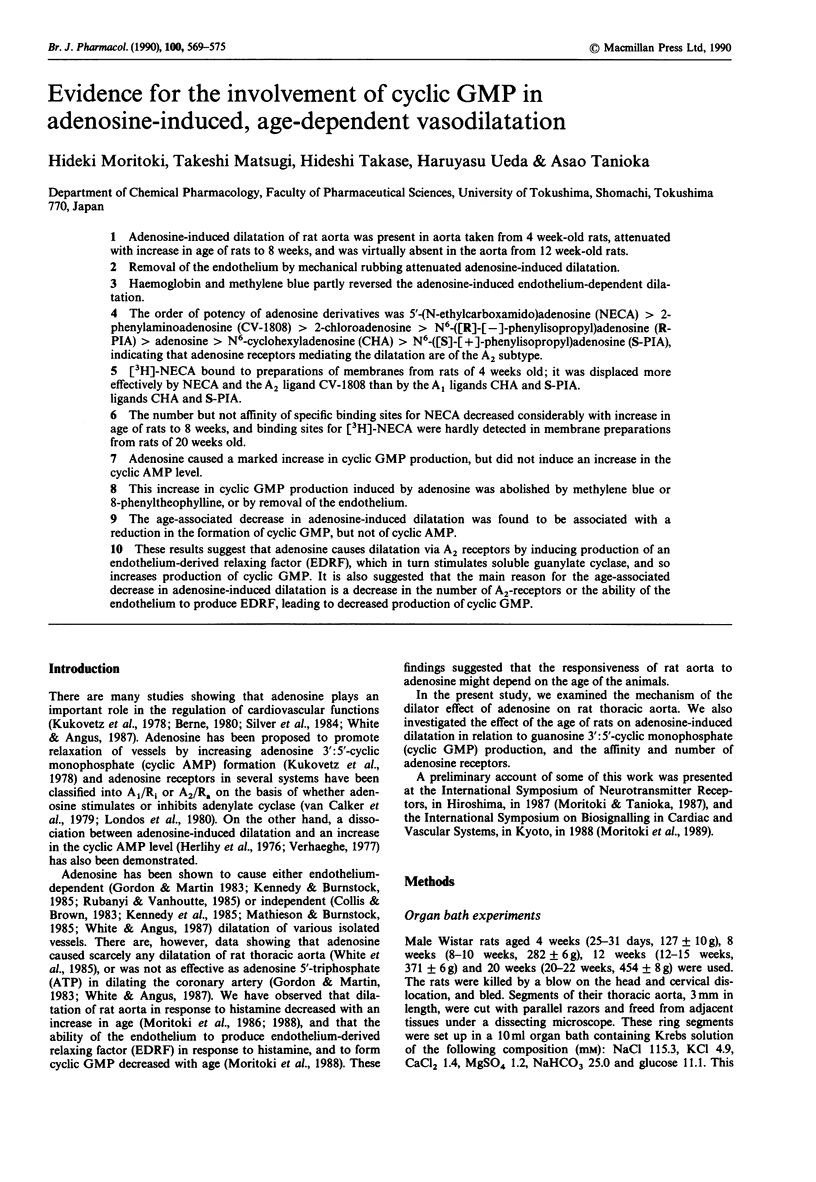
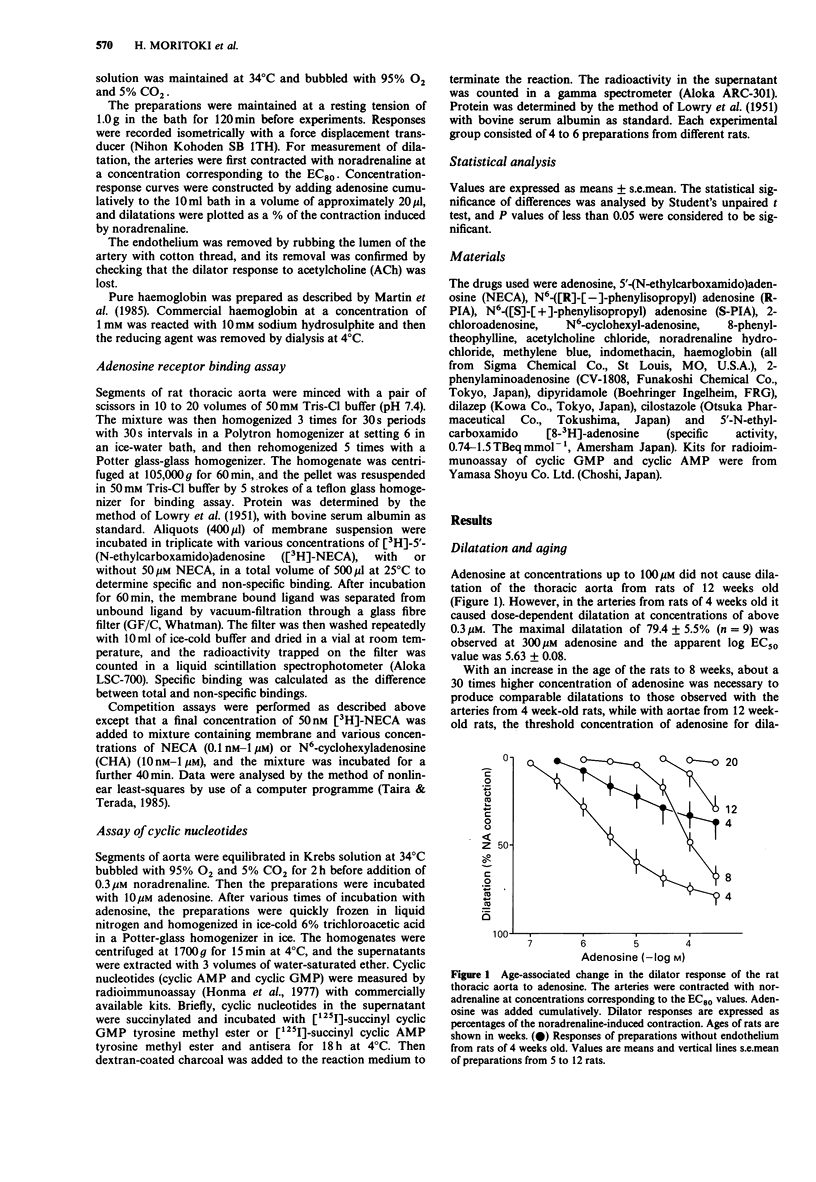
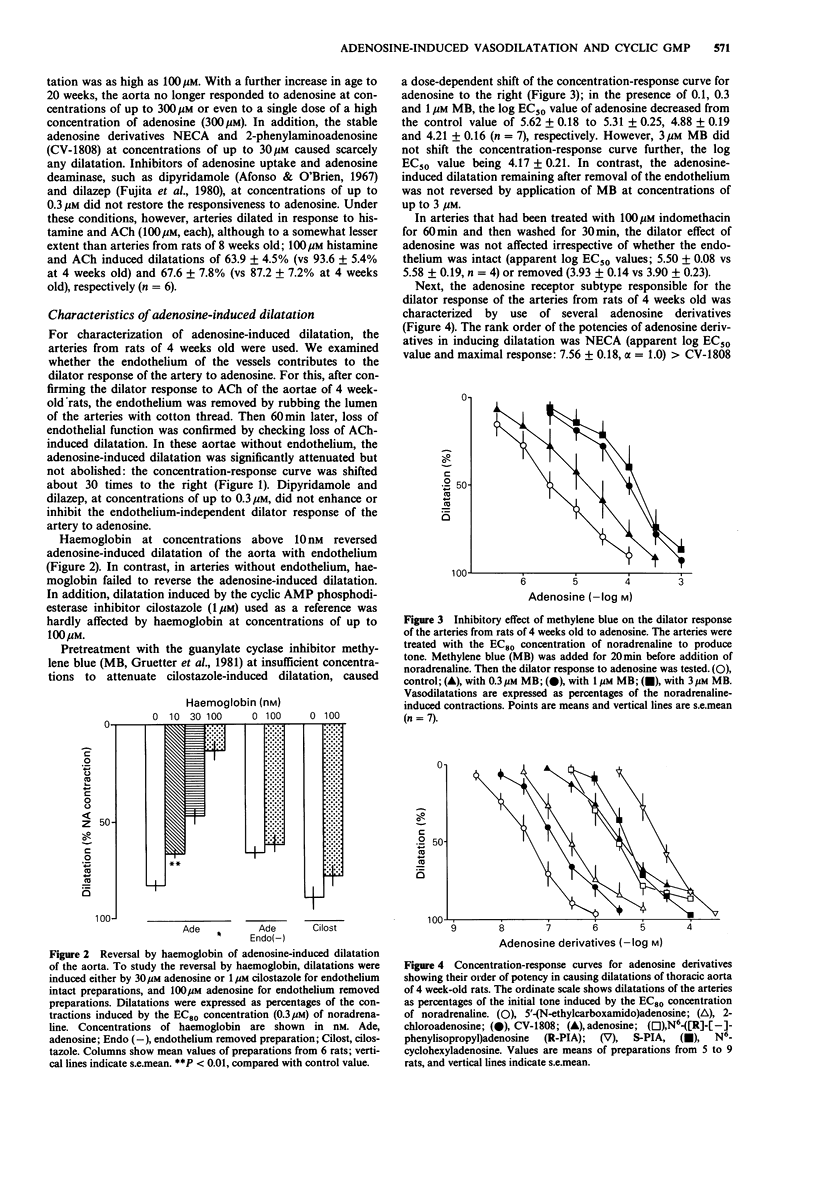
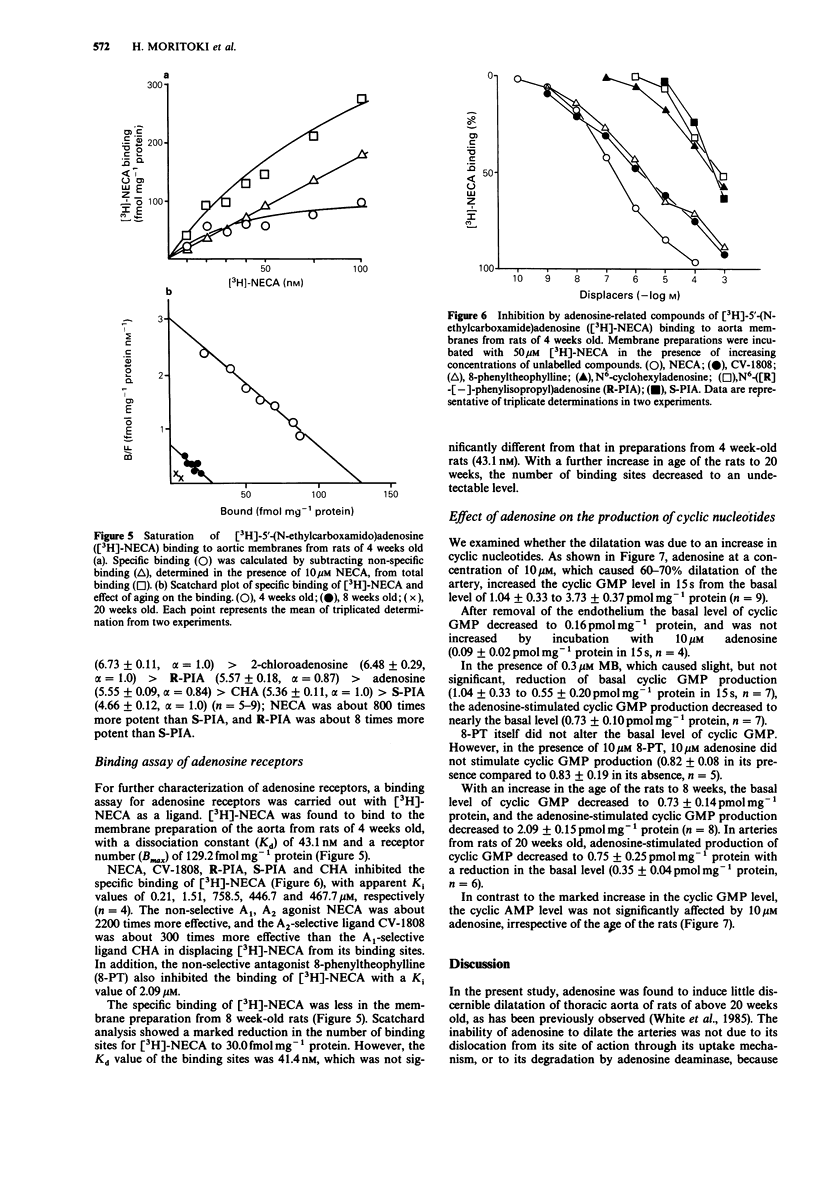
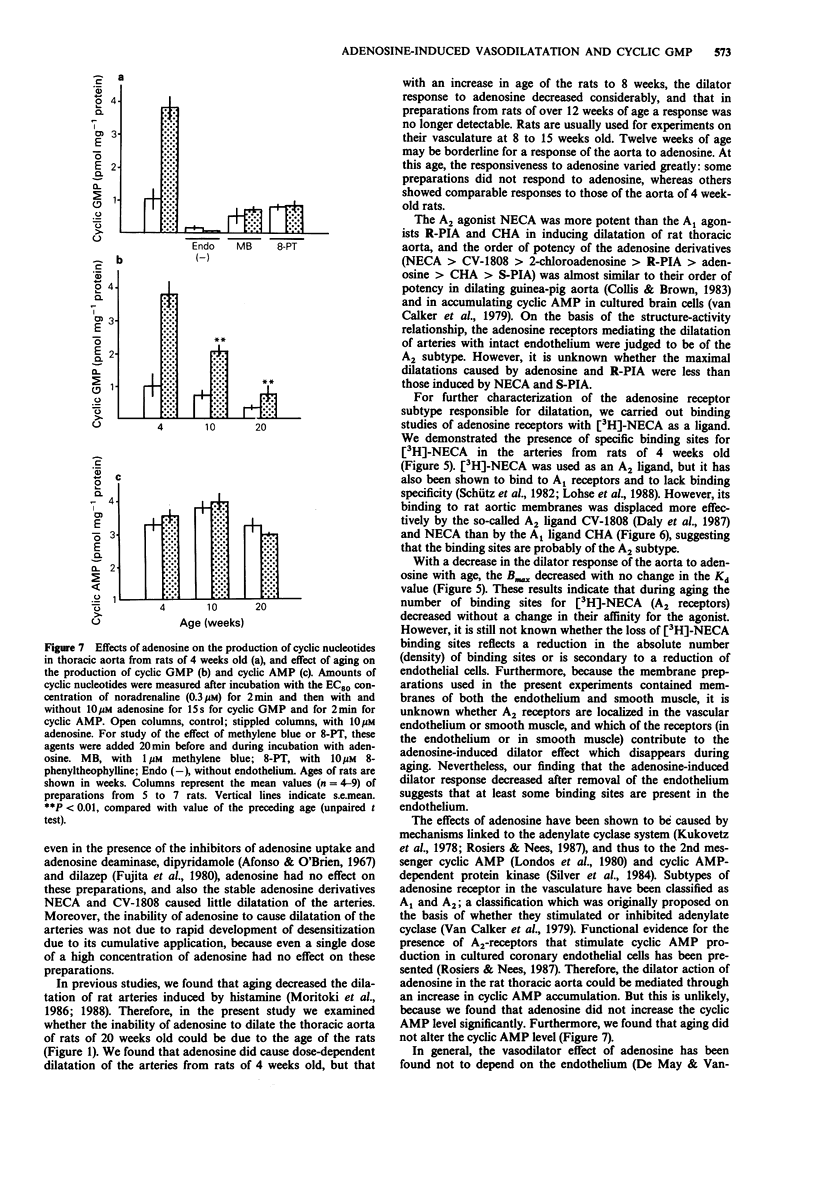
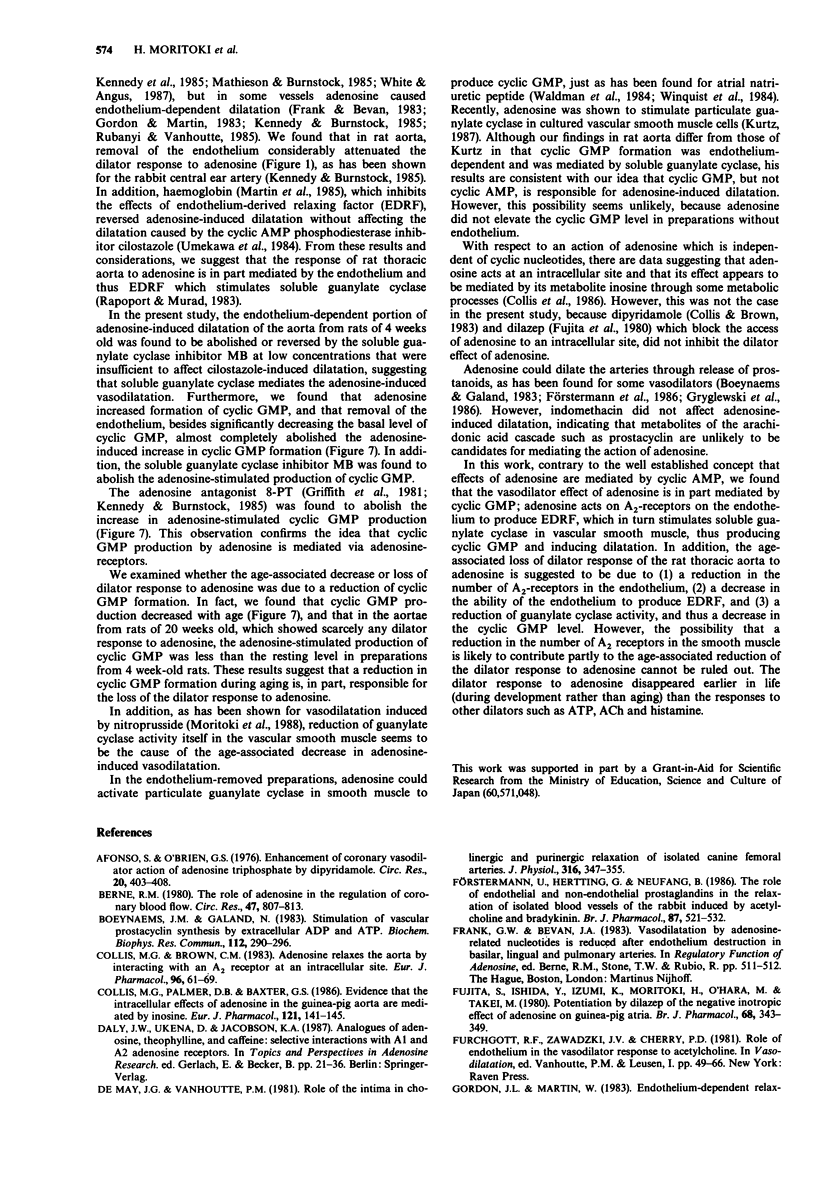

Selected References
These references are in PubMed. This may not be the complete list of references from this article.
- Afonso S., O'Brien G. S. Enhancement of coronary vasodilator action of adenosine triphosphate by dipyridamole. Circ Res. 1967 Apr;20(4):403–408. doi: 10.1161/01.res.20.4.403. [DOI] [PubMed] [Google Scholar]
- Berne R. M. The role of adenosine in the regulation of coronary blood flow. Circ Res. 1980 Dec;47(6):807–813. doi: 10.1161/01.res.47.6.807. [DOI] [PubMed] [Google Scholar]
- Boeynaems J. M., Galand N. Stimulation of vascular prostacyclin synthesis by extracellular ADP and ATP. Biochem Biophys Res Commun. 1983 Apr 15;112(1):290–296. doi: 10.1016/0006-291x(83)91829-6. [DOI] [PubMed] [Google Scholar]
- Collis M. G., Brown C. M. Adenosine relaxes the aorta by interacting with an A2 receptor and an intracellular site. Eur J Pharmacol. 1983 Dec 9;96(1-2):61–69. doi: 10.1016/0014-2999(83)90529-0. [DOI] [PubMed] [Google Scholar]
- Collis M. G., Palmer D. B., Baxter G. S. Evidence that the intracellular effects of adenosine in the guinea-pig aorta are mediated by inosine. Eur J Pharmacol. 1986 Feb 11;121(1):141–145. doi: 10.1016/0014-2999(86)90404-8. [DOI] [PubMed] [Google Scholar]
- De Mey J. G., Vanhoutte P. M. Role of the intima in cholinergic and purinergic relaxation of isolated canine femoral arteries. J Physiol. 1981 Jul;316:347–355. doi: 10.1113/jphysiol.1981.sp013792. [DOI] [PMC free article] [PubMed] [Google Scholar]
- Des Rosiers C., Nees S. Functional evidence for the presence of adenosine A2-receptors in cultured coronary endothelial cells. Naunyn Schmiedebergs Arch Pharmacol. 1987 Jul;336(1):94–98. doi: 10.1007/BF00177757. [DOI] [PubMed] [Google Scholar]
- Fujita S., Ishida Y., Izumi K., Moritoki H., Ohara M., Takei M. Potentiation by dilazep on the negative inotropic effect of adenosine on guinea-pig atria. Br J Pharmacol. 1980 Feb;68(2):343–349. doi: 10.1111/j.1476-5381.1980.tb10423.x. [DOI] [PMC free article] [PubMed] [Google Scholar]
- Förstermann U., Hertting G., Neufang B. The role of endothelial and non-endothelial prostaglandins in the relaxation of isolated blood vessels of the rabbit induced by acetylcholine and bradykinin. Br J Pharmacol. 1986 Mar;87(3):521–532. doi: 10.1111/j.1476-5381.1986.tb10194.x. [DOI] [PMC free article] [PubMed] [Google Scholar]
- Gordon J. L., Martin W. Endothelium-dependent relaxation of the pig aorta: relationship to stimulation of 86Rb efflux from isolated endothelial cells. Br J Pharmacol. 1983 Jun;79(2):531–541. doi: 10.1111/j.1476-5381.1983.tb11028.x. [DOI] [PMC free article] [PubMed] [Google Scholar]
- Griffith S. G., Meghji P., Moody C. J., Burnstock G. 8-phenyltheophylline: a potent P1-purinoceptor antagonist. Eur J Pharmacol. 1981 Oct 15;75(1):61–64. doi: 10.1016/0014-2999(81)90346-0. [DOI] [PubMed] [Google Scholar]
- Gruetter C. A., Kadowitz P. J., Ignarro L. J. Methylene blue inhibits coronary arterial relaxation and guanylate cyclase activation by nitroglycerin, sodium nitrite, and amyl nitrite. Can J Physiol Pharmacol. 1981 Feb;59(2):150–156. doi: 10.1139/y81-025. [DOI] [PubMed] [Google Scholar]
- Gryglewski R. J., Moncada S., Palmer R. M. Bioassay of prostacyclin and endothelium-derived relaxing factor (EDRF) from porcine aortic endothelial cells. Br J Pharmacol. 1986 Apr;87(4):685–694. doi: 10.1111/j.1476-5381.1986.tb14586.x. [DOI] [PMC free article] [PubMed] [Google Scholar]
- Herlihy J. T., Bockman E. L., Berne R. M., Rubio R. Adenosine relaxation of isolated vascular smooth muscle. Am J Physiol. 1976 May;230(5):1239–1243. doi: 10.1152/ajplegacy.1976.230.5.1239. [DOI] [PubMed] [Google Scholar]
- Honma M., Satoh T., Takezawa J., Ui M. An ultrasensitive method for the simultaneous determination of cyclic AMP and cyclic GMP in small-volume samples from blood and tissue. Biochem Med. 1977 Dec;18(3):257–273. doi: 10.1016/0006-2944(77)90060-6. [DOI] [PubMed] [Google Scholar]
- Kennedy C., Burnstock G. ATP produces vasodilation via P1 purinoceptors and vasoconstriction via P2 purinoceptors in the isolated rabbit central ear artery. Blood Vessels. 1985;22(3):145–155. doi: 10.1159/000158592. [DOI] [PubMed] [Google Scholar]
- Kennedy C., Delbro D., Burnstock G. P2-purinoceptors mediate both vasodilation (via the endothelium) and vasoconstriction of the isolated rat femoral artery. Eur J Pharmacol. 1985 Jan 2;107(2):161–168. doi: 10.1016/0014-2999(85)90055-x. [DOI] [PubMed] [Google Scholar]
- Kukovetz W. R., Pöch G., Holzmann S., Wurm A., Rinner I. Role of cyclic nucleotides in adenosine-mediated regulation of coronary flow. Adv Cyclic Nucleotide Res. 1978;9:397–409. [PubMed] [Google Scholar]
- Kurtz A. Adenosine stimulates guanylate cyclase activity in vascular smooth muscle cells. J Biol Chem. 1987 May 5;262(13):6296–6300. [PubMed] [Google Scholar]
- LOWRY O. H., ROSEBROUGH N. J., FARR A. L., RANDALL R. J. Protein measurement with the Folin phenol reagent. J Biol Chem. 1951 Nov;193(1):265–275. [PubMed] [Google Scholar]
- Lohse M. J., Elger B., Lindenborn-Fotinos J., Klotz K. N., Schwabe U. Separation of solubilized A2 adenosine receptors of human platelets from non-receptor [3H]NECA binding sites by gel filtration. Naunyn Schmiedebergs Arch Pharmacol. 1988 Jan;337(1):64–68. doi: 10.1007/BF00169478. [DOI] [PubMed] [Google Scholar]
- Londos C., Cooper D. M., Wolff J. Subclasses of external adenosine receptors. Proc Natl Acad Sci U S A. 1980 May;77(5):2551–2554. doi: 10.1073/pnas.77.5.2551. [DOI] [PMC free article] [PubMed] [Google Scholar]
- Martin W., Villani G. M., Jothianandan D., Furchgott R. F. Selective blockade of endothelium-dependent and glyceryl trinitrate-induced relaxation by hemoglobin and by methylene blue in the rabbit aorta. J Pharmacol Exp Ther. 1985 Mar;232(3):708–716. [PubMed] [Google Scholar]
- Mathieson J. J., Burnstock G. Purine-mediated relaxation and constriction of isolated rabbit mesenteric artery are not endothelium-dependent. Eur J Pharmacol. 1985 Dec 3;118(3):221–229. doi: 10.1016/0014-2999(85)90132-3. [DOI] [PubMed] [Google Scholar]
- Moritoki H., Hosoki E., Ishida Y. Age-related decrease in endothelium-dependent dilator response to histamine in rat mesenteric artery. Eur J Pharmacol. 1986 Jul 15;126(1-2):61–67. doi: 10.1016/0014-2999(86)90738-7. [DOI] [PubMed] [Google Scholar]
- Moritoki H., Tanioka A., Maeshiba Y., Iwamoto T., Ishida Y., Araki H. Age-associated decrease in histamine-induced vasodilation may be due to reduction of cyclic GMP formation. Br J Pharmacol. 1988 Dec;95(4):1015–1022. doi: 10.1111/j.1476-5381.1988.tb11734.x. [DOI] [PMC free article] [PubMed] [Google Scholar]
- Rapoport R. M., Murad F. Agonist-induced endothelium-dependent relaxation in rat thoracic aorta may be mediated through cGMP. Circ Res. 1983 Mar;52(3):352–357. doi: 10.1161/01.res.52.3.352. [DOI] [PubMed] [Google Scholar]
- Rubanyi G., Vanhoutte P. M. Endothelium-removal decreases relaxations of canine coronary arteries caused by beta-adrenergic agonists and adenosine. J Cardiovasc Pharmacol. 1985 Jan-Feb;7(1):139–144. doi: 10.1097/00005344-198501000-00023. [DOI] [PubMed] [Google Scholar]
- Schütz W., Steurer G., Tuisl E. Functional identification of adenylate cyclase-coupled adenosine receptors in rat brain microvessels. Eur J Pharmacol. 1982 Nov 19;85(2):177–184. doi: 10.1016/0014-2999(82)90463-0. [DOI] [PubMed] [Google Scholar]
- Silver P. J., Walus K., DiSalvo J. Adenosine-mediated relaxation and activation of cyclic AMP-dependent protein kinase in coronary arterial smooth muscle. J Pharmacol Exp Ther. 1984 Feb;228(2):342–347. [PubMed] [Google Scholar]
- Taira Z., Terada H. Specific and non-specific ligand binding to serum albumin. Biochem Pharmacol. 1985 Jun 1;34(11):1999–2005. doi: 10.1016/0006-2952(85)90322-3. [DOI] [PubMed] [Google Scholar]
- Umekawa H., Tanaka T., Kimura Y., Hidaka H. Purification of cyclic adenosine monophosphate phosphodiesterase from human platelets using new-inhibitor Sepharose chromatography. Biochem Pharmacol. 1984 Nov 1;33(21):3339–3344. doi: 10.1016/0006-2952(84)90103-5. [DOI] [PubMed] [Google Scholar]
- Waldman S. A., Rapoport R. M., Murad F. Atrial natriuretic factor selectively activates particulate guanylate cyclase and elevates cyclic GMP in rat tissues. J Biol Chem. 1984 Dec 10;259(23):14332–14334. [PubMed] [Google Scholar]
- White T. D., Angus J. A. Relaxant effects of ATP and adenosine on canine large and small coronary arteries in vitro. Eur J Pharmacol. 1987 Nov 3;143(1):119–126. doi: 10.1016/0014-2999(87)90741-2. [DOI] [PubMed] [Google Scholar]
- White T. D., Chaudhry A., Vohra M. M., Webb D., Leslie R. A. Characteristics of P2 (nucleotide) receptors mediating contraction and relaxation of rat aortic strips: possible physiological relevance. Eur J Pharmacol. 1985 Nov 26;118(1-2):37–44. doi: 10.1016/0014-2999(85)90660-0. [DOI] [PubMed] [Google Scholar]
- Winquist R. J., Faison E. P., Waldman S. A., Schwartz K., Murad F., Rapoport R. M. Atrial natriuretic factor elicits an endothelium-independent relaxation and activates particulate guanylate cyclase in vascular smooth muscle. Proc Natl Acad Sci U S A. 1984 Dec;81(23):7661–7664. doi: 10.1073/pnas.81.23.7661. [DOI] [PMC free article] [PubMed] [Google Scholar]
- van Calker D., Müller M., Hamprecht B. Adenosine regulates via two different types of receptors, the accumulation of cyclic AMP in cultured brain cells. J Neurochem. 1979 Nov;33(5):999–1005. doi: 10.1111/j.1471-4159.1979.tb05236.x. [DOI] [PubMed] [Google Scholar]


